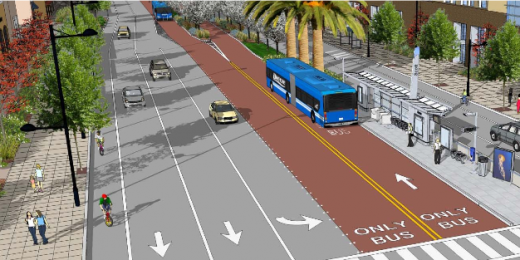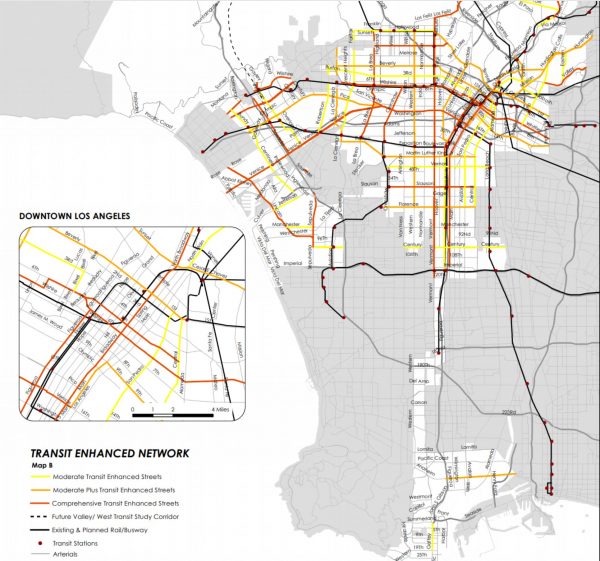
Metro Vision 2028
LA Metro has developed a comprehensive strategic plan for the next decade that will extensively improve Los Angeles’ local modes of transportation and tackle the ever-growing vehicle miles traveled (VMT) that plague the residents and commuters of this city in the form of gridlock, long commutes, air pollution, health impacts of a too-sedentary lifestyle, and more.
Metro Vision 2028 was approved by the Metro Board this past June after 18 months of research, discussion, and outreach with a number of key stakeholders. This research also included input from customers, which they defined as anyone who lives or works in LA County. It addresses the root cause of the transportation problem – increasing travel demands of a congested system – through five goals:
(1) Provide high-quality mobility options that enable people to spend less time traveling
(2) Deliver outstanding trip experiences for all users of the transportation system
(3) Enhance communities and lives through mobility and access to opportunity
(4) Transform LA through regional collaboration and national leadership
(5) Provide responsive, accountable, and trustworthy governance within Metro
Metro plans to issue periodic reports to the public on the progress toward these goals, as well as review the Plan in its entirety every 5 years.
Metro envisions that this plan will increase general welfare by removing mobility barriers and accommodating more trips with high-quality mobility options. To contextualize this vision into concrete values, they aim to double the percentage of trips via alternative modes of transportation (i.e. local transit, walking, biking) over solo driving in the following ways:
Bus Rapid Transit (BRT) & Dedicated Bus Lanes

Santa Clara Valley Transportation Authority’s rendering of dedicated lanes for bus rapid transit on El Camino Real. Santa Clara VTA. (2015).
The Bus Rapid Transit (BRT) component of the 2028 plan will primarily focus on collaboration with municipal partners and other transit operators to dedicate the resources necessary to “reclaim street space” for high-capacity vehicles. In other words, Metro will be working to develop dedicated bus lanes that will prioritize bus travel. In tandem with these partners, Metro will also be continuing its NextGen Bus Study to further field comments and suggestions from the County residents on the areas of bus transit that most need improvement. According to Jessica Meany in her Investing in Place blog post entitled “It is Time for the LA Region to Get Serious About Bus Lanes,” the NextGen study marks the first time in 25 years that Metro will comprehensively re-examine the service it provides. At the conclusion of her examination of this NextGen study she posits that, “any substantial solution must find a way to incorporate bus-only lanes on a greater number of LA’s streets.”
The Bus Rapid Transit component will split the next 10 years into two 5-year segments to strategically address the different steps necessary to achieve this goal. The first 5 years will focus on identifying and implementing measures, such as enforcement of exclusive bus lanes, that will achieve a minimum average speed of 18 mph on rapid transit routes. The next 5 years will be a concerted effort to strategically convert the most congested corridors into Bus Rapid Transit (BRT) corridors to establish a network of high-frequency, high-capacity bus service across LA county. These corridors will be implemented in partnership with local municipalities since these are the individuals who control roadways in most instances.
Success of BRT in the Past, Present, and Future
Unfortunately for Metro, a large part of implementing this plan will also need to include a strategy for reviving transit passengers’ faith in the bus system as a viable form of transportation. Many respondents to their initial survey cited that they did not feel that the buses offered them a practical way to get around the city, which they attributed to congested streets, long lines at traffic lights, and a lack of dedicated lines that prioritize bus travel. Meaney expounds upon this issue through a number of startling statistics, such as the fact that nearly 80% of bus trips originating in the downtown area took at least twice as long as the same trip by car. It is for this reason, she explains, that this plan, “will require going beyond cosmetic measures…Metro needs to show riders that buses can be trusted to get them where they’re going.”
Success stories of BRT corridors can be seen all over the world, and these projects have demonstrated that dedicated bus lanes are a powerful solution that doesn’t take years to deliver. One such example is Boston’s Washington Street bus lane. What was supposed to be a 4-week experiment has now become a permanent installation to Boston’s mobility after it was proven that bus travel times dropped 20 to 25% during the morning rush as a result of the dedicated lane. Los Angeles itself has had success with implementing bus rapid transit. Along two of the region’s most heavily-traveled arterials, Wilshire Boulevard and Ventura Boulevard, bus service was improved by adding a BRT line with increased frequency, fewer stops and traffic signal priority. These improvements decreased bus travel time by 29 percent and 23 percent respectively, and resulted in a 40 percent and 26 percent increase in ridership. Carter Rubin, the Mobility and Climate Advocate with the Natural Resources Defense Council, in a popular tweet called the bus only lanes on Lincoln Boulevard in Santa Monica “a revelation” that need to be “everywhere in LA.” It should be lauded that Metro aims to join the ranks of BRT cities with the plan it has put forth.
To get a sense of where these Bus Rapid Transit lines might go, see the Transit Enhanced Network map below. The orange lines are the transit enhanced streets that Metro intends to implement throughout the LA region.

LA Department of City Planning’s Planned Transit Enhanced Network. LA Department of City Planning. (2016)
Where Do We Go From Here?
Efforts such as this address the biggest challenges that affect mobility for L.A.’s residents and commuters. This is a diverse region that has an equally diverse set of needs, and improving transit not only decreases traffic woes, but it also has the potential to increase equity in areas such as affordable housing. The next 10 years of transportation development that Metro has set forth has great potential to improve the lives of many Angelenos. It will be imperative for community members and key stakeholders to remain active and engaged to guarantee that Metro remains pressured to truly implement these changes.